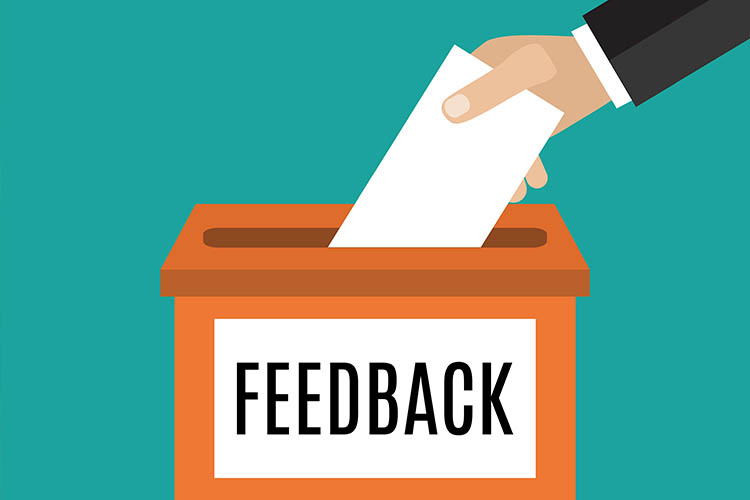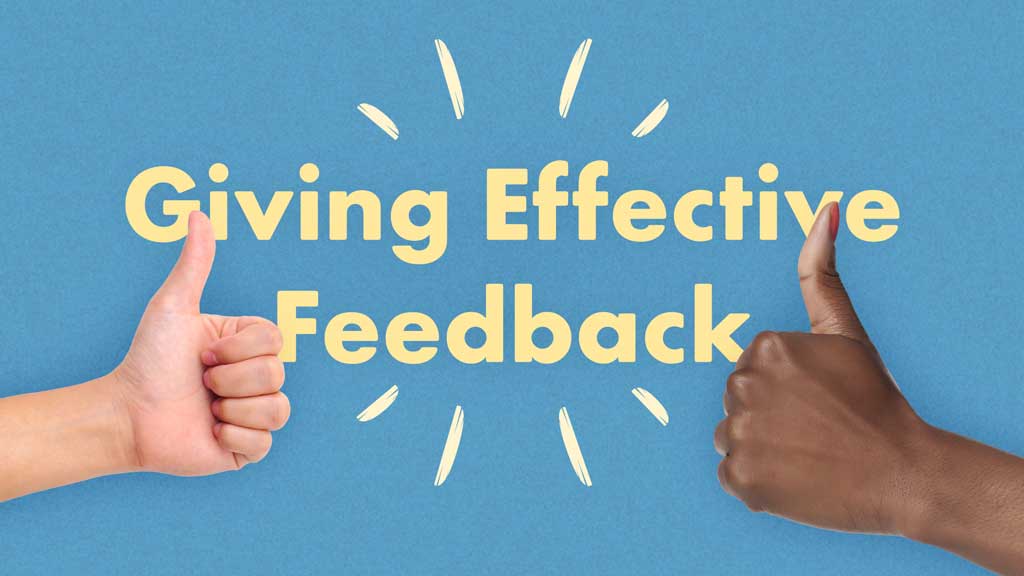Feedback helps motivate a person to perform at their best, and also clarifies any deviations between the preferred and the actual behaviour of the individual by providing information on performance.
Not only is feedback essential for professional growth, it also provides direction and increases the confidence, motivation and self-esteem of the individual (Matua et al. 2014; Rose & Best 2005).
When delivered effectively, feedback can:
- Improve performance
- Aid in learning
- Help individuals understand their strengths and deficits
- Allow learners to implement strategies to strengthen and improve their practice
- Ultimately improve patient care and outcomes.
Given the potential positives, it’s important that giving feedback becomes a priority in our practice. Despite this, feedback in healthcare settings remains a challenge for many. We can all remember a time when we have given or received some poorly delivered feedback.
New graduates, in particular, not only need constructive feedback - they also need positive feedback to know what they are doing well, and when. By understanding how well they are progressing, new staff can determine what new responsibilities they are ready to take on and what further learning should come next. Quality feedback helps the individual to realistically rate their clinical practice and minimise any poor practices (Chang & Daly 2012; Matua et al. 2014).

However, giving feedback can be difficult.
You may be worried that the recipient will take your feedback the wrong way, or perhaps you feel you don’t have enough time to deliver feedback as constructively as you would like.
Additionally, when feedback only focuses on areas needing improvement without mention of areas where the learner is excelling, the learner can feel demotivated and devalued, especially in the case of a new graduate or staff member (Duffy 2013).
Healthcare workers need to take responsibility for their own behaviours and must be proactive in both seeking and offering feedback, rather than only giving feedback in reaction to an adverse event or performance (Chang & Daly 2012).
The incidence of feedback can be encouraged by the recipient receiving it in a professional manner. This can then encourage and create a positive work environment where everyone gives and receives feedback openly.
Giving Feedback
There are many sources of feedback in healthcare. For instance, a patient smoothly transitioning home can be interpreted as the result of good planning and providing sufficient patient information.
Colleagues can also be a source of feedback.
The use of several different sources of information will add credibility to feedback that is being given, whether it is positive or negative (Chang & Daly 2012; Rose & Best 2005).
New staff should also be encouraged to reflect on their practices and behaviours themselves, to determine their strengths and weaknesses. This will help identify areas in which they need continuing education and allow them to reach their full potential (Chang & Daly 2012).
Feedback Models
There are many different feedback models available, and there is no ‘right way’ to give effective feedback. The model you choose to utilise will depend on the feedback recipient and the situation.
1. The Feedback Sandwich
This feedback tool consists of three components:
- Begin with positive feedback
- Then, introduce constructive or negative feedback
- Close with specific feedback that builds up the learner’s trust and comfort.
The feedback sandwich aims to minimise any detrimental effect the negative feedback may have on the individual and ensures that the learner is not discouraged (Matua et al. 2014).
2. Situation-Behavior-Impact Feedback Tool
This tool allows the learner to reflect more on their actions whilst understanding precisely what you are commenting on and why, as well as what needs to change.
- Begin by identifying the situation the feedback refers to
- Then, define the specific behaviours you want to address
- End by describing how their behaviours impacted you or others.
The Situation-Behavior-Impact tool offers the learner a chance to reflect on the situation from another perspective, and an opportunity to discuss strategies for improvement (Jackson n.d.).
3. Pendleton’s Model of Feedback
Pendleton’s model of feedback helps make the learning experience constructive by:
- Highlighting positive behaviours
- Reinforcing these behaviours and including a discussion of skills to achieve them
- Discussing what the person could have done differently.
Areas of improvement are first identified by the learner and then followed up with a discussion about strategies to improve their performance (Chowdhury & Kalu 2004).

Characteristics of Effective Feedback
Any of the above models can be used to deliver feedback; however, to be effective, the feedback must display certain characteristics:
- Specific: Feedback should contain specific examples rather than generalisations.
- Accurate: Feedback should be factual and clear.
- Objective: Feedback should be unbiased and unprejudiced.
- Timely: Feedback should be given as soon as possible after the completion of a task (when appropriate).
- Usable: Relate the feedback to goals and strategies so the individual can improve their performance.
- Desired by the receiver: Feedback can still be effective even in those who don’t actively seek it. However, those seeking feedback will often be more motivated to improve performance.
- Checked for understanding: Clarify understanding with the individual to ensure they are getting the most out of their feedback.
(Matua et al. 2014; Rose & Best 2005)
Effective feedback that is clear, focused and given regularly, even when negative in nature, will often still allow the individual to be comfortable with the person giving the feedback, providing it displays these characteristics.
Feedback should also mention specific strategies the individual can use to improve their learning and performance, and also guide their next steps (Matua et al. 2014).
Timely and effective constructive feedback is especially essential in the case of a staff member who is underperforming. It gives the learner a chance to rectify a situation that could potentially leave them failing if they are a student, or cause harm and potential dismissal if they are a new graduate (Duffy 2013).
Receiving Feedback
Learners need to have an active role in their own feedback conversation. If a learner doesn’t implement feedback provided by an educator, the educator should consider the following:
- How was the feedback delivered?
- Was the learner able to contribute their perspective?
- Were they able to have a hand in devising goals that will enable them to enact the feedback and improve their performance?
Remember: Enabling the learner to have an active role in their feedback conversation encourages investment in the process, providing further motivation to change (Chang & Daly 2012; Cox 2016; Delany & Malloy 2018).
Negative Feedback
When receiving negative feedback, there can be a tendency for some learners to become defensive.
Feedback can challenge the learner’s views about themselves: it can create a sense of discomfort, which can then cause them to become defensive, and not only challenge the feedback provided, but also the credibility of the individual providing the feedback.
In this situation, the relationship between the two individuals is pivotal in ensuring the feedback is understood and the emotional state of the learner is protected (Delany & Malloy 2018).
It should be noted that negative feedback can also be perceived as criticism, even though the feedback may have been given with the intention of assisting the learner to improve. This can trigger feelings of shame and guilt.
Past Feedback
It is important to remember that learners also bring their prior experiences with feedback situations to their current feedback conversation. This can impact how they respond depending on the circumstances, their knowledge levels and their prior experience.
For example, if the learner had an experience receiving feedback that left them feeling demoralised, then this can have an effect on their emotional state when receiving feedback in the future (Delany & Malloy 2018).
The Feedback Environment
As an educator, it is important to build a safe feedback environment where learners feel comfortable and supported. It needs to be an environment where feelings can be discussed, especially when mistakes are made and there are feelings of shame or guilt (Cox 2016; Van Der Leeuw 2014).
Test Your Knowledge
Question 1 of 3
True or false: Feedback should only be given in response to an adverse event or performance.
Topics
References
- Chang, E & Daly, J 2012, Transitions in Nursing: Preparing for Professional Practice, 3rd edn, Elsevier, Sydney.
- Chowdhury, RR & Kalu, G 2004, ‘Learning to Give Feedback in Medical Education’, The Obstetrician and Gynecologist, vol. 6, viewed 2 May 2023, https://www.researchgate.net/publication/227674254_Learning_to_give_feedback_in_medical_education
- Cox, S 2016, ‘Give the Gift of Feedback’, Nursing Management, vol. 47, no. 5, viewed 1 May 2025, https://www.ausmed.com.au/cpd/articles/giving-feedback/view
- Delany, C & Malloy, E 2018, Learning and Teaching in Clinical Contexts: A Practical Guide, Elsevier, Chatswood.
- Duffy, K 2013, ‘Providing Constructive Feedback to Students During Mentoring’, Nursing Standard, vol. 27, no. 31, viewed 1 May 2025, https://journals.rcni.com/nursing-standard/providing-constructive-feedback-to-students-during-mentoring-ns2013.04.27.31.50.e7334
- Hardavella, G, Aamli-Gaagnat, A, Saad, N, Rousalova, I & Sreter, KB 2017, ‘How to Give and Receive Feedback Effectively’, Breathe, vol. 13, no. 4, viewed 1 May 2025, https://www.ncbi.nlm.nih.gov/pmc/articles/PMC5709796/
- Jackson, K n.d., 'The Situation-Behavior-Impact™ Feedback Tool', Mind Tools, viewed 1 May 2025, https://www.mindtools.com/ay86376/the-situation-behavior-impact-feedback-tool
- Matua, GE, Seshan, V, Akintola, AA & Thanka AN 2014, ‘Strategies for Providing Effective Feedback During Preceptorship: Perspectives from an Omani Hospital’, Journal of Nursing Education and Practice, vol. 4, no. 10, viewed 1 May 2025, https://www.sciedu.ca/journal/index.php/jnep/article/view/4612
- Rose, M & Best, D (eds.) 2005, Transforming Practice Through Clinical Education, Professional Supervision and Mentoring, Elsevier, Sydney.
- Sodeify, R, Vanaki, Z & Mohammadi, E 2013, ‘Nurses’ Experiences of Perceived Support and their Contributing Factors: A Qualitative Content Analysis’, Iranian Journal of Nursing and Midwifery Research, vol. 18, no. 3, viewed 1 May 2025, https://www.ncbi.nlm.nih.gov/pmc/articles/PMC3748536/
- Van Der Leeuw, RM 2014, ‘Sharing is Caring: Dealing with Feedback and Difficult Feelings’, Medical Education, vol. 48, no. 11.
 New
New 
